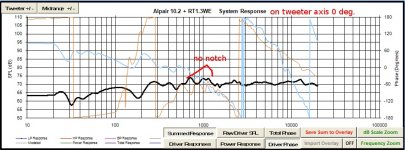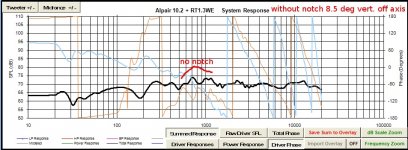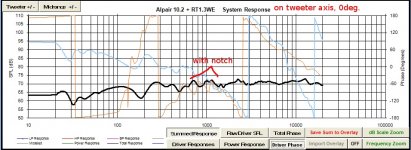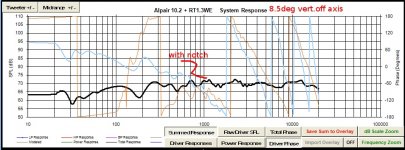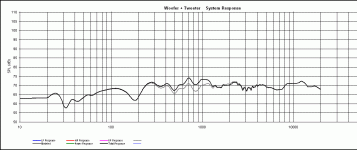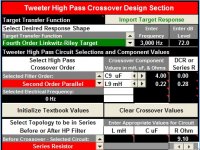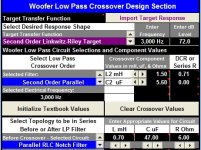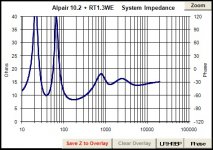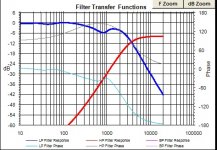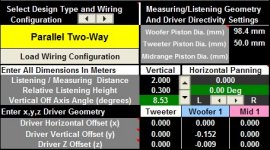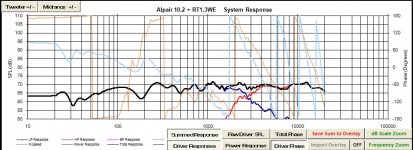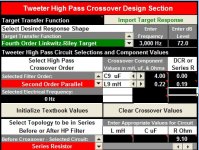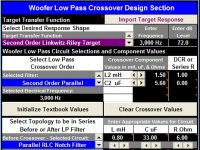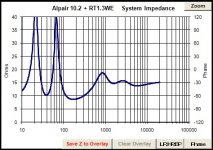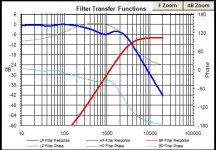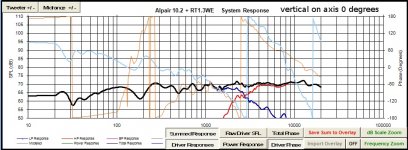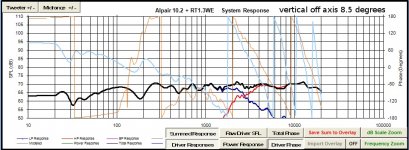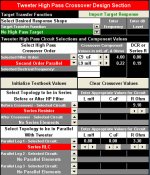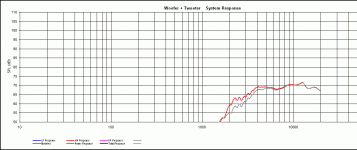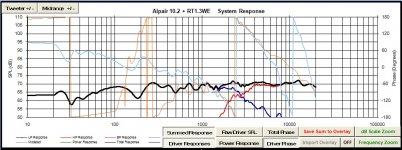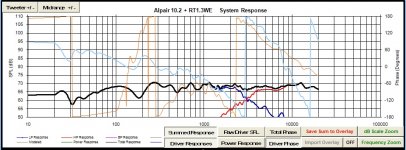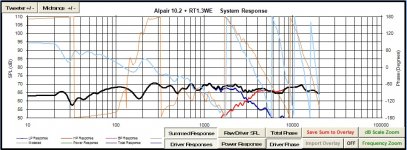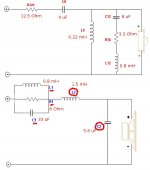I've spent today working on a simple 2nd order xover with and without a notch filter.
Please see attached with and without the notch filter. I'm not sure it's worth the extra three parts, what do you think?
Without checking phase alignment of the drivers, you're kind of stabbing in the dark. Individual driver acoustic phase.
Later,
Wolf
Ben,
As you already know, speaker design is a process that takes time
and simulation is not everything. Eventually you will have to build
a prototype filter and evaluate the sound for yourself. Surely the
difference of the 2 graphs is not that big. Maybe you will prefer
the notchless one, who knows. Slightly forward sounding speaker
in the shorter run can be more attractive. Real hifi sounding speakers
have a power response that slightly decreases in spl toward higher
frequencies.
As you already know, speaker design is a process that takes time
and simulation is not everything. Eventually you will have to build
a prototype filter and evaluate the sound for yourself. Surely the
difference of the 2 graphs is not that big. Maybe you will prefer
the notchless one, who knows. Slightly forward sounding speaker
in the shorter run can be more attractive. Real hifi sounding speakers
have a power response that slightly decreases in spl toward higher
frequencies.
Ok, here are four screenshots, with and without the notch filter, 0 degrees and 8.5 degrees vertical off axis. These are all with the driver phase. Please let me know what you think, if the notch is worth it or not especially since I'm looking to keep it simple. Thanks 
Attachments
Ok, here are four screenshots, with and without the notch filter, 0 degrees and 8.5 degrees vertical off axis. These are all with the driver phase. Please let me know what you think, if the notch is worth it or not especially since I'm looking to keep it simple. Thanks
Keep the notch, IMO.
Wolf
Keep the notch, IMO.
Wolf
Do you think it's in the best place (brings down the 700-1K area I think)?
L 0.70 mH
C 40 uF
R 3 Ohm
The rest of the xover is quite simple if you need this info as context:
Woofer L2 1.2 mH, C2 6 uF
Tweeter C9 3 uF, L9 0.3 mH and the series resistor is 8 Ohm
Thanks for all of your help.
All right, semi-final crossover here. I tweaked the crossover part values to available values for affordable parts from PE.
I'm thinking due to cost and size the 47 uF in the notch will be just a non-polar electrolytic. There is a 10% tolerance on these but I don't think it will do much harm one way or the other.
Please see attached pictures of the simulation and part values in PCD. Note that changing any of the axis values does not change the summed response very much with this crossover so I think that's a pretty good sign. If you all see any improvements that should be made, let me know.
I'm thinking due to cost and size the 47 uF in the notch will be just a non-polar electrolytic. There is a 10% tolerance on these but I don't think it will do much harm one way or the other.
Please see attached pictures of the simulation and part values in PCD. Note that changing any of the axis values does not change the summed response very much with this crossover so I think that's a pretty good sign. If you all see any improvements that should be made, let me know.
Attachments
I was not completely happy with the peak around 1.1K and figured with a 10% tolerance part it could be even a little bit worse in reality, so I changed the notch filter values a little bit. I also corrected the DCR values of the inductors. AND, as a bonus I have both the 8.5 degree vertical off-axis and 0 degree on-axis system response sims.
Here it is again, below. Semi- semi- final!
Here it is again, below. Semi- semi- final!
Attachments
You tweeter will appreciate receiving less power with this modification.
Here is a good and cheap part for this notch that needs a bit of work:
https://www.parts-express.com/ferrite-core-crossover-inductor-25mh-21-awg-125-watt--269-303
Here is a good and cheap part for this notch that needs a bit of work:
https://www.parts-express.com/ferrite-core-crossover-inductor-25mh-21-awg-125-watt--269-303
Attachments
Try this: click to invert tweeter polarity, move vertical axis up and down until you find the deepest null at xover, put the polarity back, and see how the phase tracking looks on whatever that angle is.
P.S. I think you might have it a bit too hot in the upper half of the spectrum, or at least 1-5k or so, but not positive, haven't really checked out the driver measurements enough.
P.S. I think you might have it a bit too hot in the upper half of the spectrum, or at least 1-5k or so, but not positive, haven't really checked out the driver measurements enough.
Last edited:
Try this: click to invert tweeter polarity, move vertical axis up and down until you find the deepest null at xover, put the polarity back, and see how the phase tracking looks on whatever that angle is.
P.S. I think you might have it a bit too hot in the upper half of the spectrum, or at least 1-5k or so, but not positive, haven't really checked out the driver measurements enough.
Note this is without Lojzek's suggested additional notch (thanks by the way)
Following your instructions, the deepest null seemed to be at +2.86 degrees setting.
Here attached is the result after putting the polarity back (what do you think? Maybe a little more resistor on the tweeter?):
Attachments
Note this is without Lojzek's suggested additional notch (thanks by the way)
Following your instructions, the deepest null seemed to be at +2.86 degrees setting.
Here attached is the result after putting the polarity back (what do you think? Maybe a little more resistor on the tweeter?):
I still think you need more tweeter attenuation, or these will sound HOT.
Later,
Wolf
I still think you need more tweeter attenuation, or these will sound HOT.
Later,
Wolf
Attached are the system response for on and off axis (listening position) respectively with a 12.5 ohm resistor instead of the 9.1. I also added Lojzek's notch that smooths the tweeter's decay. Is that enough so that it won't sound "hot?" Thanks
Attachments
Attached are the system response for on and off axis (listening position) respectively with a 12.5 ohm resistor instead of the 9.1. I also added Lojzek's notch that smooths the tweeter's decay. Is that enough so that it won't sound "hot?" Thanks
As long as the BSC is fully compensated, and the bass rolloff in room is better than pictured below 200Hz, then you should be fine as pictured.
If that response is real, and you have only response from 200-20k, I recommend a woofer, making it a 3-way- xover'd at 200 Hz.
Later,
Wolf
If that response is real, and you have only response from 200-20k, I recommend a woofer, making it a 3-way- xover'd at 200 Hz.
Well sir, I think I have a room that has acoustical problems. As evidence I offer this close mic measurement of the woofer:
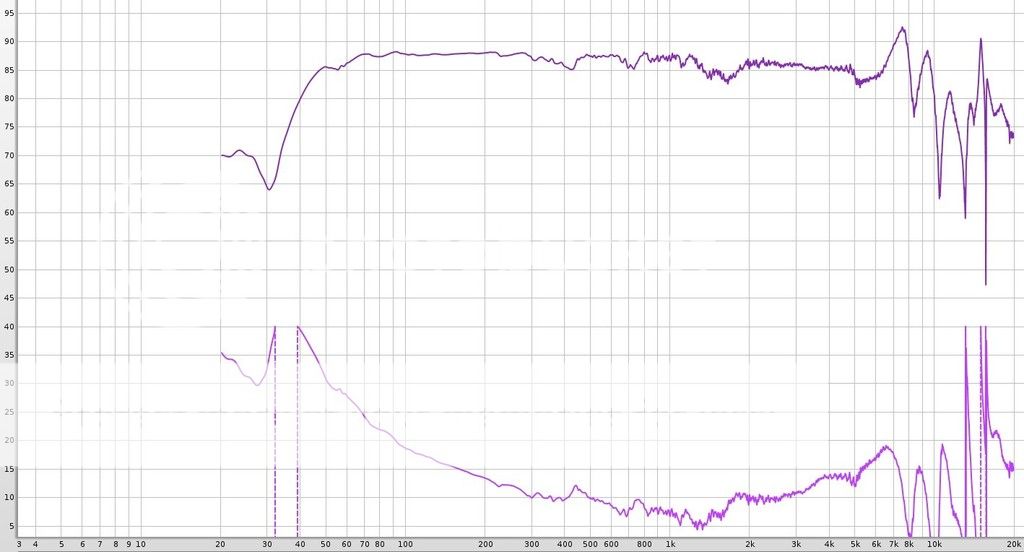
In practice these will be crossed over to subwoofer(s) at 100 Hz but I did want to design something that could stand alone too.
As to whether BSC has been addressed, folks say these Alpairs have built-in BSC.
Well sir, I think I have a room that has acoustical problems. As evidence I offer this close mic measurement of the woofer:

In practice these will be crossed over to subwoofer(s) at 100 Hz but I did want to design something that could stand alone too.
As to whether BSC has been addressed, folks say these Alpairs have built-in BSC.
Is that with or without xover in place? If it's without, then your nearfield looks like you won't need much BSC. I'm not sure your farfield will also yield the same conclusion since nearfield always has enhanced bass extension in the measurements. This is why the far and near are typically spliced for the best measurements.
I personally say proceed and see. You might be just fine.
Later,
Wolf
Well sir, I think I have a room that has acoustical problems.
As evidence I offer this close mic measurement of the woofer:
As to whether BSC has been addressed, folks say these Alpairs
have built-in BSC.
Whenever you put a speaker like yours on a stand, you have a floor bounce.
Diffraction and Boundary Simulator helps to visualize it.
Folks have seen the manufacturer's measurement, hence their conclusion.
You have better data and it clearly shows how much there is BSC. Whether
one wants to do something about it, is a different matter. Hifi rules are clear.
Is that with or without xover in place? If it's without, then your nearfield looks like you won't need much BSC. I'm not sure your farfield will also yield the same conclusion since nearfield always has enhanced bass extension in the measurements. This is why the far and near are typically spliced for the best measurements.
I personally say proceed and see. You might be just fine.
The close mic measurement is just the woofer in box playing directly from the amp. No filter or crossover at all. Mic is about 1.5" from the cone center.
I suppose I'll proceed and build the crossovers and re-measure. Figure in a couple weeks I'll be back here asking for opinions again
That looks good. It also means you've got the forward lobe aimed in that direction, which seems like a decent compromise between straight ahead and up for your intended placement.Following your instructions, the deepest null seemed to be at +2.86 degrees setting.
In the post I'm quoting, definitely, but your most recent sim above looks about right. It's hard to say for sure from the data you've got.Here attached is the result after putting the polarity back (what do you think? Maybe a little more resistor on the tweeter?):
Is this graph below from the same REW measurement that you're currently using, except with a shorter gate? If so, I think the 70dB flat portion on here just might be the accurate baseline level for the woofer, although it would be nice to have more like 4ms clean than 2.6. Try swapping it in and see how your notch action looks on that response.

- Status
- This old topic is closed. If you want to reopen this topic, contact a moderator using the "Report Post" button.
- Home
- Loudspeakers
- Multi-Way
- Ben's "Hi-Marks" Fullranger + Isodynamic Tweeter 2-Way Build Thread
